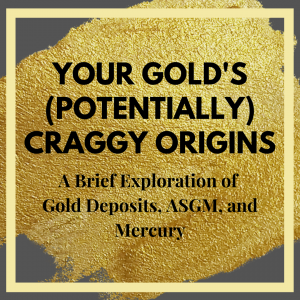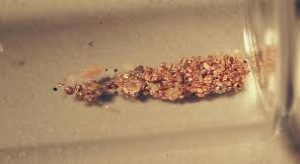
Although gold is a modern necessity, as adornment, an antiviral, circuitry, and much more, we do not question its source. This is the first in a series of posts exploring the irreplaceable metal, from its origins, chemistry, and geology to extraction, processing, and much more, while placing an emphasis on ASGM’s role in the gold supply chain. Our journey begins in this post by investigating gold’s extraterrestrial origins, followed by its modern occurrence, and concludes by highlighting how this leads to mercury utilization during processing.
Precluding computers, jewelry, bacteria, and even the solar system, our gold was synthesized through the incredible nuclear fusion of the big bang. Following this synthesis, it hurdled throughout the universe for billions of years, believed to have congregated in asteroids. Studies suggest the metal arrived on Earth approximately 100 million years into our planet’s life, when these gold-bearing asteroids collided with our young planet and melting upon impact. Through the next several billion years, our planet cooled and the denser elements, like gold, sank towards the core. Because of this differentiation, scientists estimate Earth’s core contains enough gold to cover the surface 13 inches deep!
While concentrated in Earth’s center, gold surrounds us, microscopic quantities are incorporated into the modern surface at an average of slightly less than half a part per billion! Unfortunately, we cannot extract our gold from this abundant source and cannot reach Earth’s core leaving us to ponder. Where does our gold come from?
Natural concentrations of valuable materials known as deposits, fill our demand for gold and other mined materials. Exploratory geologists, prospectors, and others, dedicate their careers searching for deposits, utilizing a mixture of luck, skill and knowledge to find elusive deposits where valuable materials are often incorporated within other minerals, and/or found in low concentrations. For example, a deposit with 5 grams of gold per ton of surrounding rock, would be considered a rich deposit nowadays! Because identification of these nearly invisible elements is difficult, experts use centuries of research to classify and identify deposits, for our interest in gold there are two major styles of deposition placer and lode.
Popular images of mining, the black and white photos of bearded men bent over babbling brooks, panning,
 depict placer deposit exploitation. Placers are best characterized by the presence of “free gold” concentrated through natural processes. Because of gold’s density, when liberated from gangue material/host rock, it is more resistant to motion than the surrounding sediment. As a result, the “free gold” particles will remain motionless while other sediment is transported, increasing its concentration, and resulting in placer deposits.
depict placer deposit exploitation. Placers are best characterized by the presence of “free gold” concentrated through natural processes. Because of gold’s density, when liberated from gangue material/host rock, it is more resistant to motion than the surrounding sediment. As a result, the “free gold” particles will remain motionless while other sediment is transported, increasing its concentration, and resulting in placer deposits.
The most common occurrence for this is within streams or rivers, specifically known as alluvial placer deposits, where water displaces lighter sediments and concentrates the hefty gold, although less common, wind (eolian), inclined slopes (elluvial), and wave action also has been the source of gold deposits. Miners use this knowledge and search for black magnetite sands in the bends of waterways, the base of slopes, or on beaches, as a possible indicator of gold. Placer deposits were once historically prominent, but following mass exploitation, rich placer deposits are now rare. Miners now primarily search for gold locked within the gangue rocks and minerals, known as lode deposits.
Also known as primary deposits, in this style, the gold particles are encased within the surrounding host/gangue rock. While individual deposits vary in formation, they are broadly the consequence superheated and intensely pressurized fluids often expelled from magma. The fluid dissolves precious metals and minerals more abundant several kilometers under the surface. In this super-saturated and super-heated state, the fluid infiltrates cracks, crevices, and pores attempting to decrease its heat and pressure. As the fluid rises, depressurizes, and cools, the dissolved materials will precipitate out of the solution as solids. Materials with higher melting points, and lower solubility, precipitate at depth where the temperature is higher, in comparison, metals such as gold, silver, and copper, precipitate closer to the surface in unique, cooler, environments. To effectively concentrate metals, the fluid must be cool in a unique and rare gradient that results in a lode deposit.
These deposits pose a variety of difficulties for mining because the gold is not easily discernable from other minerals along with commonly being microscopic. To further add to the difficulty of extraction, the gold is often concentrated or entrapped with other metallic minerals such as chalcopyrite, pyrite, magnetite, hematite, and others.

Above is an example of large gold flakes from a placer deposit. These “free gold” particles were once a reliable source of gold for miners. Yet over time these deposits have become increasingly rare and miners must turn towards finer gold interlocked in lode deposits.
While larger flakes of “free gold” in placer deposits, can be extracted by simpler classic mining methods, modern lode deposits, have too fine of gold, are too dispersed, and pose other novel difficulties that require alternative mining methods. To be extracted, miners must first grind the gold ore to a fine powder, millimeters in size, and then use alternative methods to effectively separate and concentrate the gold.
Unless you are a miner or geologist, this information may seem to be extraneous, but understanding gold’s origins is significant to understanding why ASGM turns to mercury. Due to the microscopic flakes, and co-occurrence with other materials, miners rely upon mercury-based processing methods, which currently poison our planet with 2,000 tons of mercury pollution a year! Without an effective alternative this pollution irreversibly harms hundreds of thousands across the globe, and significantly degrades our environment. Understanding that the gold we use daily, could be sourced using mercury, a result of the deposit, highlights the dire need to develop an effective mercury free gold extraction alternative.
To navigate the complications of modern gold deposits, many may suggest that ASGM utilize chemical, processes common within large scale mine operations. Yet with vast capital, expertise, resources, and other factors of future discussion large scale miners have the unique capability to safely control incredibly complex hydro and pyrometallurgical processes that are simply impractical for use within artisanal and small scale mines. This poses an issue as nearly 20% of the gold supply, must use alternative means to extract gold, leading to mercury’s use. Mercury Free Mining proposes that we seek an alternative to the perpetuation of this harmful substance, through developing a novel mercury-free process to separate and extract gold we would be able to exploit these deposits without irreversibly harming the well being of miners, their communities, and our environment.
Overall, through learning about the origins of gold and the resulting complexities of extracting it, we are able to better understand why miners turn to using mercury and how, if provided with a alternative means to extraction we can radically improve the well-being of our world. In future posts we will take a deeper dive into the other characteristics of gold and ASGM that further highlights our need for a mercury free method for extracting gold.
About the Author: Caelen Burand is a mining engineering and geology student currently studying at the University of Arizona. He intends to use his education and experience to aid artisanal and small scale miners in his career and is currently the social media/general aid intern for Mercury Free Mining. To contact him please visit his Linkedin page, https://www.linkedin.com/in/caelen-burand-570176172/#
References:
Anne Marie Helmenstine, Ph.D. “Do You Know These 10 Fun Facts About Gold?” ThoughtCo, 30 Jan. 2020, www.thoughtco.com/interesting-gold-facts-607641#:~:text=Gold Facts
“Making the Grade: Understanding Exploration Results.” MINING.COM, 24 Mar. 2017, www.mining.com/web/making-the-grade-understanding-exploration-results/#:~:text=GOLD: One ounce, or roughly,tonne is usually economically viable.
Pitcairn, I.K., Teagle, D.A.H., Craw, D., Olivo, G.R., Kerrich, R., Brewer, T.S. (2006a) Sources of metals in orogenic gold deposits: insights from the Otago and Alpine Schists, New Zealand. Economic Geology, v. 101, p. 1525–1546
The Editors of Encyclopedia Britannica. “Placer Deposit.” Encyclopædia Britannica, Encyclopædia Britannica, Inc., 15 Dec. 2010, www.britannica.com/science/placer-deposit.
Wee, Rolando Y. “Did You Know The Gold In The Earth’s Core Could Cover The Earth In A Knee-High Layer?” WorldAtlas, WorldAtlas, 25 Apr. 2017, www.worldatlas.com/articles/did-you-know-the-gold-in-the-earth-s-core-could-cover-the-earth-in-a-knee-high-layer.html.
